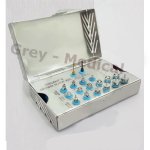greymedical
New member
The success of dental implant procedures goes beyond the quality of the implants themselves; it also hinges on the proper sterilization of dental tools. This blog delves into the significance of sterilization in dental implant tools and the practices that ensure patient safety.
1. Understanding Sterilization
Sterilization is the process of eliminating all forms of microbial life, including bacteria, viruses, and spores, from instruments. In dentistry, maintaining a sterile environment is crucial to prevent infections, which can jeopardize the success of dental implants.
2. Common Dental Implant Tools Requiring Sterilization
Dental practices typically follow strict sterilization protocols, which include:
Regularly inspecting and maintaining sterilization equipment is vital. Dental practices should monitor the effectiveness of their sterilization processes through biological indicators, which confirm that sterilization has occurred.
Conclusion
The importance of sterilization in dental implant procedures cannot be overstated. By adhering to stringent sterilization protocols for dental implant tools, dental professionals can significantly reduce the risk of infection, ensuring safer procedures and better patient outcomes. Patients should feel confident in their dental care providers' commitment to maintaining a sterile environment.
1. Understanding Sterilization
Sterilization is the process of eliminating all forms of microbial life, including bacteria, viruses, and spores, from instruments. In dentistry, maintaining a sterile environment is crucial to prevent infections, which can jeopardize the success of dental implants.
2. Common Dental Implant Tools Requiring Sterilization
- Surgical Kits: Tools like implant drivers, drills, and forceps must undergo rigorous sterilization processes before use. This includes cleaning, disinfecting, and autoclaving the instruments to ensure they are free of contaminants.
- Suction Tips: These tools are used to remove blood and debris from the surgical site and must be sterile to avoid introducing bacteria into the implant area.
- Impression Trays: Since they come into direct contact with the patient's mouth, impression trays must also be sterilized before taking impressions for implant prostheses.
Dental practices typically follow strict sterilization protocols, which include:
- Cleaning: Instruments are first cleaned to remove any debris. This step is crucial for ensuring effective sterilization.
- Disinfection: After cleaning, instruments are disinfected using chemical agents to reduce microbial load.
- Autoclaving: Finally, tools are subjected to autoclaving, a process that uses steam under pressure to kill bacteria and spores. This ensures that the instruments are sterile and safe for patient use.
Regularly inspecting and maintaining sterilization equipment is vital. Dental practices should monitor the effectiveness of their sterilization processes through biological indicators, which confirm that sterilization has occurred.
Conclusion
The importance of sterilization in dental implant procedures cannot be overstated. By adhering to stringent sterilization protocols for dental implant tools, dental professionals can significantly reduce the risk of infection, ensuring safer procedures and better patient outcomes. Patients should feel confident in their dental care providers' commitment to maintaining a sterile environment.

